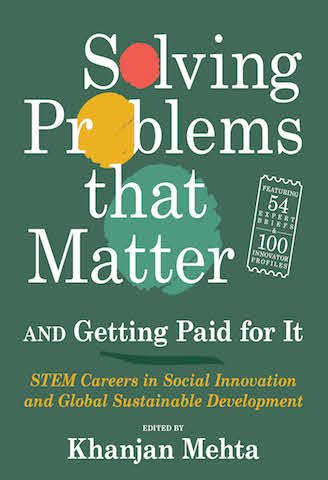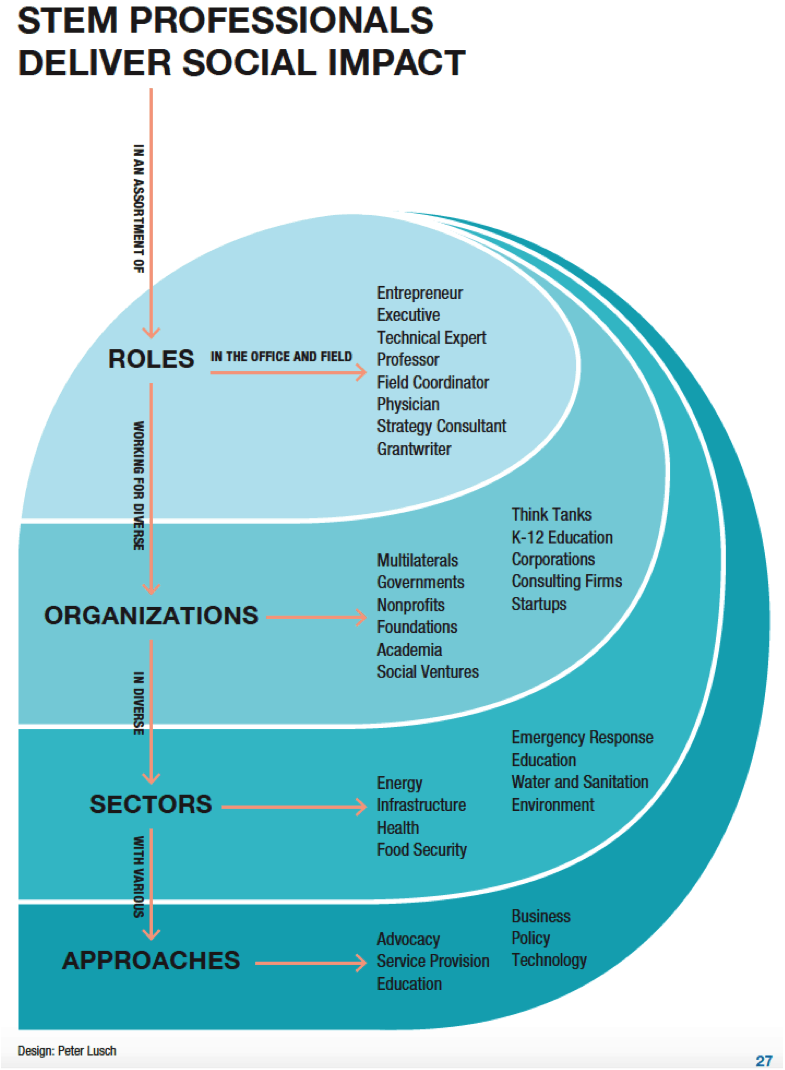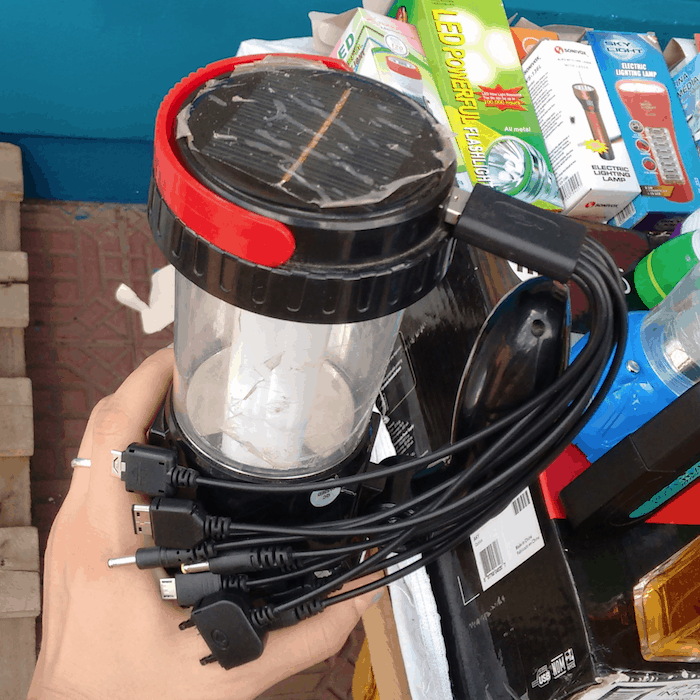NexThought Monday: The Role of STEM Professionals in Global Sustainable Development
Editor’s note: This is the first post in a series exploring careers in social innovation and global sustainable development for science, technology, engineering and math (STEM) professionals. You can read the other posts here. The author discusses the issue in more depth in an ebook, available for free download here, and in his recent TEDx Talk.
From medicines and germ theory through fertilizers, the telephone and the microchip, STEM has always been about improving the human condition. This was true when the Romans built their aqueducts, when al-Khwarizmi wrote his treatises, and when Sushruta classified surgeries. Today we see it in the mission statements of professional organizations: the Institute of Electrical and Electronics Engineers aims to “advance technology for humanity,” Doctors Without Borders wants to “help doctors help patients,” and the Royal Society of Chemistry studies “for the sake of knowledge and benefit of mankind.” These and other STEM fields shape the foundation of efforts that empower rural farmers in Tanzania, educate grandmothers in India, improve water quality in Flint, Michigan, and build better clinics across the Philippines. Yet most people today would not consider mechanical engineering or biochemistry as care-giving professions vital to the advancement of humanity.
The STEM community is changing. While STEM professionals have always been motivated by the prospect of inventions helping society, today we have many more ways to engage directly in that process. Academic programs, co-curricular clubs, and professional organizations are springing up across disciplines and countries to address diverse global sustainable development challenges. Today’s tech- and business-oriented world wants entrepreneurial approaches to international development, and STEM talent and resources are flocking towards empowering the next billion.
Genesis: Why this Series Exists
The Humanitarian Engineering and Social Entrepreneurship (HESE) Program at Pennsylvania State University, where I serve as founding director, engages students and faculty across campus in rigorous research-to-launch cycles for technology-based social enterprises in low- and middle-income countries. Through a series of five courses that include fieldwork, HESE teams systematically advance ventures toward large-scale and long-term economic, social and environmental bottom lines. Alongside social enterprises, students work on original publishable research that strengthens ventures with evidence-based and data-driven approaches.
HESE seeks to provide STEM and non-STEM students with transformative experiences that develop the skills, competencies and mindsets necessary to launch entrepreneurial ventures and pursue careers in global sustainable development. After such immersive and impactful experiences over multiple years, these passionate, hardworking students are not as excited about taking up well-paying, but arguably monotonous, jobs in large corporations. Their big question is: What do we do next? What are the career pathways for professionals who want to leverage their education and passion to improve the human condition?
 To answer some of these questions, I spent over three years interacting with hundreds of innovators trying to address dozens of development challenges across diverse sectors, organizations and countries. Over two-thirds of them were scientists and engineers and about half were women; they were entrepreneurs and managers and researchers. They worked at non-profits, foundations, the United Nations, the State Department, small businesses and large corporations. And they all believed in the power of science, technology and innovation to solve societal challenges.
To answer some of these questions, I spent over three years interacting with hundreds of innovators trying to address dozens of development challenges across diverse sectors, organizations and countries. Over two-thirds of them were scientists and engineers and about half were women; they were entrepreneurs and managers and researchers. They worked at non-profits, foundations, the United Nations, the State Department, small businesses and large corporations. And they all believed in the power of science, technology and innovation to solve societal challenges.
With the help of an excellent editorial team, I turned these conversations into a 400-page book, Solving Problems That Matter (and Getting Paid for It), which includes 54 expert briefs penned by leaders from USAID, Peace Corps, MIT, Engineers Without Borders, the American Association for the Advancement of Science, and other organizations. In addition, 100 STEM innovators from the World Bank, UNICEF, Village Capital, Gates Foundation, Google, and dozens of social ventures, government agencies, nonprofits, academic institutions, and corporations shared enlightening and inspiring career profiles. These profiles are packed with a diverse set of current roles and responsibilities, unique career trajectories, and real-life lessons learned along the way. The goal of our book is to educate students, parents, faculty and career counselors about pathways in social innovation and global sustainable development.
In this series, I will share some of my broadest lessons learned on the journey towards Solving Problems That Matter. Together we will investigate where scientists and engineers fit in the sustainable development space.
STEM Professionals: Roles, Organizations, Sectors and Philosophies of Engagement
Social innovation and sustainable development are championed by a bewildering array of actors across the public, private, social and amalgamating “fourth sector.” These organizations leverage different kinds of resources and pursue different opportunities to effect social change. They work on a wide array of societal grand challenges like food security, global health, education, and increasingly at the nexus of these challenges. Most importantly, they espouse many different approaches to development, and these philosophies (education-based, market-centric, technology-driven and so on) fundamentally inform organizations’ values.
Although I work with STEM students and practitioners on a daily basis, here are five themes that continually surfaced as I researched the book, as well as examples of the many professionals whose contributions were published in it:
#1 STEM Professionals are Everywhere
At its heart, the STEM mindset is a scientific approach to understanding the world and a problem-solving drive to make it better. You are as likely to find STEM degrees in finance offices and strategic planning teams as you are on the factory floor and testing laboratories. For example, Srik Gopal is a mechanical engineer by training. Today, though, he is the director of FSG’s strategic evaluation area, heading project evaluations that improve organizational effectiveness and impact. There are countless jobs in sustainable development that champion the scientific paradigm and STEM problem solving, regardless of your values or interests.
#2 Perpetual Search for Stronger Platforms
Having one mission does not mean you have only one path. The innovators I interviewed embraced the complex ecosystem of sustainable development organizations, and they never stopped searching for their next best platform. The key to navigating the sustainable development space as a STEM or a non-STEM professional is to be active. Our ecosystem is filled with useful resources, great people and huge impact opportunities, but we have to reach them. For instance, Riana Lynn has been on a longtime mission to improve public health with her background in biology, technology and public policy. This passion has driven her from coordinating research at the University of Chicago, to supporting the White House’s “Let’s Move” campaign and STEM programs, to helping international students apply for US STEM programs with ChaseFuture, to now leading a food technology and traceability company, FoodTrace. Every position, every platform, brings new opportunities and challenges, and every organization can benefit from the skills we transfer in with us.
#3 Importance of Values and Philosophy of Engagement

STEM professionals play diverse roles in various kinds of organizations across several sectors. These organizations espouse different values and approaches to sustainable development.
As I interviewed innovators for this book, I realized that what most of them look for is finding their “fit.” It is not the organization type, the development sector, or even their own job that matters most; it is their organization’s approach and values. Frank Bergh’s first job out of college was as a consultant supporting over 50 wind farms for clients ranging from large utilities to small upstart developers. It was a great opportunity, but over time he felt like his brain was for rent to the highest bidder. In an effort to stay with renewable energy, he joined a German wind-turbine manufacturer and become the lead engineer for grid interconnection in North and South America. This gave him even more insight into the field, and after a few years he considered if wind farms were the wrong approach for many developing nations’ needs. So he switched platforms again, this time to a small renewable-energy startup that reflected his view of solar being more applicable than wind for humanitarian development. After a few more years, he wanted to influence solar energy more profoundly so he switched platforms to SoCore Energy, a large corporation that provided him the opportunity to innovate the way retail and industrial consumers conceive their energy supply.
#4 Solving Problems that Matter can be Lucrative
One of the most common myths about nonprofits and impact-focused organizations is that their salaries are significantly lower than the corporate world—and so are their work expectations. While nonprofit salaries are often lower, this conventional wisdom is quickly blurring. I have interviewed many talented and passionate people in both sectors, and salaries of domain experts are often comparable. In fact, some jobs see more variation between nonprofit organizations than between nonprofit and corporate positions. Exactly the same kind of work might get you an annual salary anywhere between $25,000 and $250,000. The median salary of the innovators I interviewed was over $80,000, a tad bit over the perfect salary for happiness. STEM professionals today really can focus their careers on creating societal value without compromising personal finances and quality of life.
#5 STEM is About Doing; Not Just Learning
One third of the social innovators I interviewed for this book did not have formal education in a STEM field, but leveraged STEM in their work. For example, Mark Randall has a bachelor’s degree in fine arts, which he uses to operate a design studio. His studio and foundation run diverse social change projects, from the Urban Forest Project, which promoted environmental sustainability in New York City, to Create! Don’t Hate, which championed tolerance among college students. Meanwhile, Kosta Grammatis has a bachelor’s degree in liberal studies but runs Oluvus, an organization dedicated to making the Internet more accessible for all. In the end, STEM versus non-STEM is an unnecessary dichotomy. It takes a planet to solve our global grand challenges.
Khanjan Mehta is the Founding Director of the Humanitarian Engineering and Social Entrepreneurship Program at Penn State.
Top image: Nicholas Frazzette will be graduating from Penn State in spring 2016 with an master’s degree in Biomedical Engineering. He plans to pursue a fellowship at at the National Institutes of Health and hopes to continue his human-centered design work by developing new therapies and medical technologies for cancer treatment. (Image credit: Penn State)
- Categories
- Energy, Technology
- Tags
- employment, innovation



